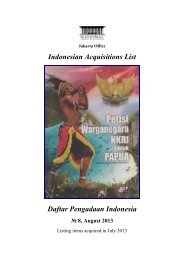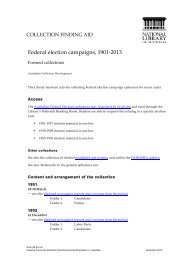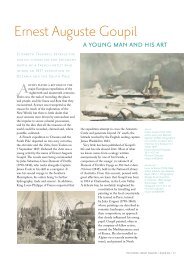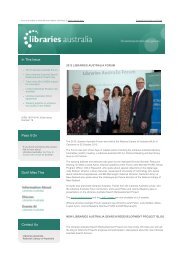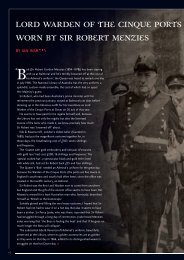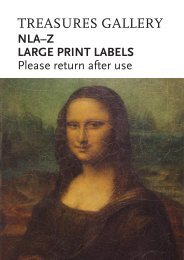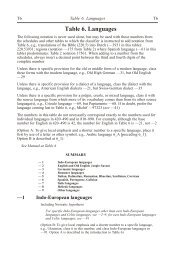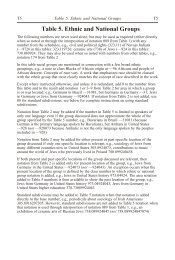Download the National Library Magazine - National Library of ...
Download the National Library Magazine - National Library of ...
Download the National Library Magazine - National Library of ...
Create successful ePaper yourself
Turn your PDF publications into a flip-book with our unique Google optimized e-Paper software.
and sent home to demonstrate <strong>the</strong> necessity<br />
<strong>of</strong> ‘civilising’ <strong>the</strong>m, to confirm colonists’<br />
perceptions <strong>of</strong> <strong>the</strong>mselves as sober and<br />
industrious, or to give credence to notions<br />
about a ‘dying race’. This makes such portraits<br />
enormously troubling to present-day eyes.<br />
A typical response to Fernyhough’s images<br />
is to see <strong>the</strong>m as exploitative caricatures,<br />
derogatory depictions <strong>of</strong> ‘types’ ra<strong>the</strong>r than<br />
<strong>of</strong> individuals, and inextricable from <strong>the</strong><br />
prejudices <strong>of</strong> <strong>the</strong> time. It is indeed true that<br />
<strong>the</strong> hardening and expansion <strong>of</strong> colonisation,<br />
and <strong>the</strong> corresponding escalation <strong>of</strong> conflict,<br />
was having powerful implications for art,<br />
particularly portraiture. By <strong>the</strong> 1830s, colonial<br />
aspirations were positioning Indigenous people<br />
as obstructive to order and progress, giving rise<br />
to derogatory images depicting <strong>the</strong>m as ragged,<br />
intoxicated, violent or inherently incapable <strong>of</strong><br />
‘civilised’ behaviour. At <strong>the</strong> same time, <strong>the</strong><br />
commonly held belief in <strong>the</strong> white community<br />
that Indigenous people were fated to disappear<br />
fed <strong>the</strong> demand for images documenting <strong>the</strong>m.<br />
Interestingly, however, this latter attitude<br />
also occasioned portraits that, though<br />
created for such reasons, succeeded in<br />
presenting <strong>the</strong>ir sitters as individuals ra<strong>the</strong>r<br />
than curiosities, <strong>the</strong>reby suggesting critical<br />
observations <strong>of</strong> <strong>the</strong> ways in which contact<br />
was diminishing Indigenous ways <strong>of</strong> life.<br />
Among <strong>the</strong> tremendous riches <strong>of</strong> <strong>the</strong> <strong>National</strong><br />
<strong>Library</strong>’s Pictures Collection are many works<br />
that exemplify this aspect <strong>of</strong> Australian art<br />
and portraiture in <strong>the</strong> 1830s, including two<br />
sets <strong>of</strong> <strong>the</strong> 1836 edition <strong>of</strong> William Henry<br />
Fernyhough’s Twelve Pr<strong>of</strong>ile Portraits <strong>of</strong> <strong>the</strong><br />
Aborigines <strong>of</strong> New South Wales. The same<br />
decade that could produce such seemingly<br />
prejudiced depictions also saw <strong>the</strong> creation<br />
<strong>of</strong> remarkably sensitive images by artists like<br />
Bock and Rodius, <strong>the</strong> memorialising history<br />
paintings by Benjamin Duterrau (1767–1851)<br />
and <strong>the</strong> idealised representations <strong>of</strong> Indigenous<br />
life featured in <strong>the</strong> work <strong>of</strong> John Glover<br />
(1767–1849), which might be read as a lament,<br />
or as an acknowledgment <strong>of</strong> <strong>the</strong> pr<strong>of</strong>ound<br />
impact <strong>of</strong> dispossession. Fernyhough’s Twelve<br />
Pr<strong>of</strong>ile Portraits were indeed cheap, poorly<br />
executed and unsympa<strong>the</strong>tic, and recent<br />
scholarship has shown that <strong>the</strong>y became<br />
more so in subsequent reprints. But it may be<br />
argued that <strong>the</strong> first edition <strong>of</strong> Fernyhough’s<br />
portraits has significance today as a series <strong>of</strong><br />
frank depictions <strong>of</strong> dispossessed people that<br />
somehow eludes <strong>the</strong> narrow and dispassionate<br />
contexts <strong>of</strong> <strong>the</strong>ir making, just as Rodius in<br />
1834 had depicted his sitters with potent visual<br />
reminders <strong>of</strong> colonisation’s impact. The result<br />
is portraits that, despite <strong>the</strong>ir commercial<br />
intentions and <strong>the</strong> prejudices that underline<br />
<strong>the</strong>m, are equally capable <strong>of</strong> conveying an<br />
opposite, alternative view, and <strong>of</strong> presenting<br />
enduring representations <strong>of</strong> individuals and<br />
people impacted by contact.<br />
JOANNA GILMOUR is a Curator at <strong>the</strong> <strong>National</strong><br />
Portrait Gallery<br />
below left<br />
Benjamin Duterrau (1767–1851)<br />
Portrait <strong>of</strong> Truganini, Daughter<br />
<strong>of</strong> <strong>the</strong> Chief <strong>of</strong> Bruny Island, Van<br />
Diemen’s Land c. 1835<br />
oil on canvas; 88.2 x 68.1 cm<br />
Pictures Collection<br />
nla.pic-an2283035<br />
below right<br />
John Glover (1767–1849)<br />
Corroboree c. 1840<br />
oil on canvas; 55.5 x 69.4 cm<br />
Pictures Collection<br />
nla.pic-an2246425<br />
THE NATIONAL LIBRARY OF AUSTRALIA MAGAZINE :: DECEMBER 2013 :: 11



